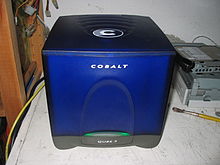- Server appliance
-
 Snap Server 650
Snap Server 650
A server appliance is a computer appliance that works as a server. It is designed so that the end-user does not need to understand the details of the operating system or the commands associated with it. Server appliances have their hardware and software preconfigured by the manufacturer. The appliance is plugged into an existing network and is turned on by the end-user. The user selects the components to be active, through a simple user interface, and the appliance then boots to an active state, which is usable within minutes. Server appliances are designed to run and be controlled remotely after the initial set-up. The units are designed to be very easy to operate and provide narrow selection of network services.
Examples of server appliances include the Google Mini, a search appliance designed for indexing corporate websites and returning these results,[1] as well as the ASA Firewall, a security appliance designed to protect IP networks from unwanted inbound traffic.[2] or IBM's Lotus Foundations which is designed to offer IT infrastructure services for the small to midsize business.
Contents
Purpose
Server appliances, unlike other computer appliances, provide server-related services, such as: FTP, e-mail, DNS, VPN, firewall and print spooling services. They also operate as a web server or a NAS or SAN Storage Server.
Typical usage
A server appliance can be integrated into an existing network's infrastructure.
Server appliances are often used in situations where there is a lack of IT staff resource. This can include SME and branch networks where they may be no resource at all and corporate networks where use of an appliance can allow less qualified staff to help manage the network.
The initial network or configuration may be entered through touch pad/push buttons on the front of the units,[3] via a serial/VGA console or is set by DHCP.
For further configuration and/or maintenance these devices usually offer access to the server appliance through an internal web server. These web servers may listen on a special port and not on the normal port 80 for security reasons.[4]
The now unavailable Cobalt Networks RaQ series was previously purchased by ISPs who used them to sell hosting, FTP and/or email services to clients, giving them remote administrative access directly to the machine.[5]
Server appliances can also be utilized for non-traditional IT network functions, such as for remote product support. An early example[citation needed] developed by Pratt & Whitney in 2001 in the aerospace industry is the Onboard Internet Microserver, which extends an http network into a complex product at the subsystem level, such as an aircraft, using an embedded micro-web server. It acts as the host and user interface between the subsystem's controller and both local and remote users, primarily for product support functions such as remotely collecting, processing, accessing and transferring of operational data, as well as onboard hosting of technical maintenance information for local operator access. They can also be used to facilitate two way communications between operators in the field and the factory through normal web server supported functions such as email, ftp, chat, or even VoIP and video, depending upon wireless communications speeds available. Devices such as these, when deployed in a clustered network architecture, known as Network Centric Product Support (NCPS), can create remote product support capabilities capable of being scaled to large fleets, where every product and its components become nodes in a supply chain supported network.
Some appliances especially Storage appliances are based on common-used but certified or recommended server-hardware. Usually hardware and software are sold together (example NexentaStor ZFS-storage appliance). But there are also non-commercial or free software alternatives to build a server-appliance on recommended but regular hardware like NexentaStor Community edition or the napp-it ZFS appliance based on a free server-os like NexentaCore, OpenIndiana or other Solaris-based Distros.
See also
References
- ^ Enterprise Solutions: Google Mini, Google Inc., Accessed: June 13, 2007.
- ^ CISCO Pix Security at a Glance, CISCO Systems, Accessed: June 14, 2007.
- ^ Sun Cobalt: "Using the LCD Control Station", page 1-1. Sun Microsystems, 2005
- ^ Admin Access on Port 81, Sun Cobalt, September 2003
- ^ "Sun Cobalt RaQ 550 Server Appliance", Page 1, Sun Microsystems, August 8, 2005.
Further reading
- Sun Microsystems RaQ 550 Datasheet Accessed June 10, 2007.
- Webopedia "What is server appliance? - A Word Definition From the Webopedia Computer Dictionary", May 6, 2002. Accessed June 10, 2007.
- Gaskin, James "Why use a server appliance?", Network World, May 21, 2001. Accessed June 10, 2007.
- ApplianSys "Making network managers' lives easier", Appliansys Corporate Website, Accessed June 12, 2007.
- Network attached storage devices
- Crowley, Tom MBX Systems "Aha! What your refrigerator can tell you about selling software", Enterprise Open Source Magazine, July 14, 2006
- "Appliances vs. Traditional Servers: Pros and Cons", Hitachi ID Corporate Website, Accessed October 21, 2008.
- NexentaStor 3.0: Storage-Appliance mit OpenSolaris | heise open
Accessed March 29, 2010
Categories:
Wikimedia Foundation. 2010.

